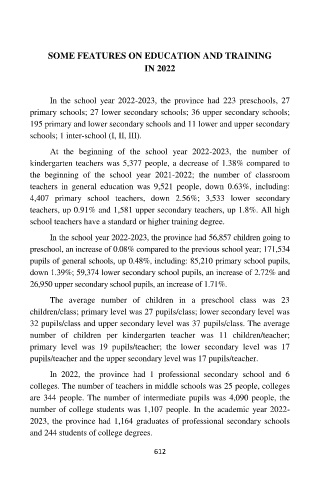Page 653 - niengiam2022
P. 653
SOME FEATURES ON EDUCATION AND TRAINING
IN 2022
In the school year 2022-2023, the province had 223 preschools, 27
primary schools; 27 lower secondary schools; 36 upper secondary schools;
195 primary and lower secondary schools and 11 lower and upper secondary
schools; 1 inter-school (I, II, III).
At the beginning of the school year 2022-2023, the number of
kindergarten teachers was 5,377 people, a decrease of 1.38% compared to
the beginning of the school year 2021-2022; the number of classroom
teachers in general education was 9,521 people, down 0.63%, including:
4,407 primary school teachers, down 2.56%; 3,533 lower secondary
teachers, up 0.91% and 1,581 upper secondary teachers, up 1.8%. All high
school teachers have a standard or higher training degree.
In the school year 2022-2023, the province had 56,857 children going to
preschool, an increase of 0.08% compared to the previous school year; 171,534
pupils of general schools, up 0.48%, including: 85,210 primary school pupils,
down 1.39%; 59,374 lower secondary school pupils, an increase of 2.72% and
26,950 upper secondary school pupils, an increase of 1.71%.
The average number of children in a preschool class was 23
children/class; primary level was 27 pupils/class; lower secondary level was
32 pupils/class and upper secondary level was 37 pupils/class. The average
number of children per kindergarten teacher was 11 children/teacher;
primary level was 19 pupils/teacher; the lower secondary level was 17
pupils/teacher and the upper secondary level was 17 pupils/teacher.
In 2022, the province had 1 professional secondary school and 6
colleges. The number of teachers in middle schools was 25 people, colleges
are 344 people. The number of intermediate pupils was 4,090 people, the
number of college students was 1,107 people. In the academic year 2022-
2023, the province had 1,164 graduates of professional secondary schools
and 244 students of college degrees.
612

